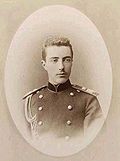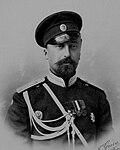This article relies largely or entirely on a single source .(February 2022) |
The topic of this article may not meet Wikipedia's general notability guideline .(February 2024) |

This is a list of those members of the Russian imperial family who bore the title velikiy knjaz (usually translated into English as grand duke, but more accurately grand prince). This courtesy title was borne by the sons and male-line grandsons of the Emperor of all the Russias, along with the style of His Imperial Highness. They were not sovereigns, but members and dynasts of the House of the reigning emperor.
Contents
The title grand prince is the English translation of the Russian великий князь. The Slavic knyaz and the Baltic kunigaitis (both nowadays usually translated as prince) is a cognate of king. [1]








































